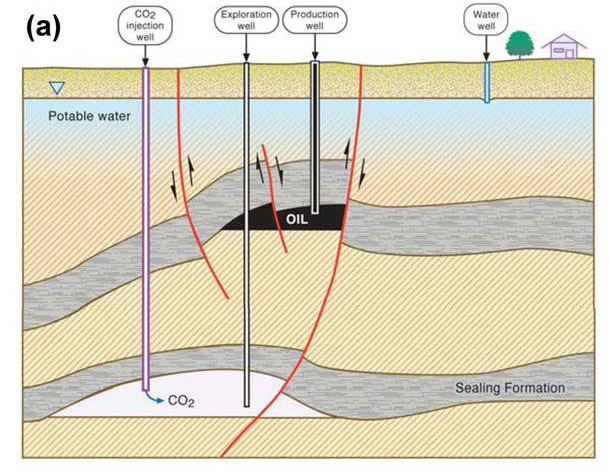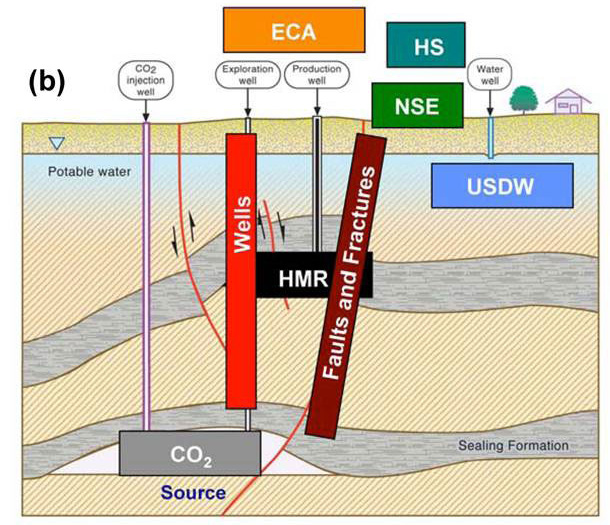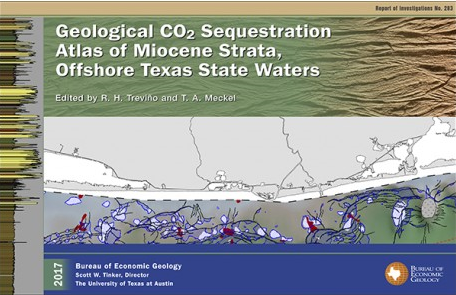CO2 Capture Project Certification Framework
2006–2011 Program Overview
The third phase of the CO2 Capture Project Certification Framework (CCP CF) was to develop a simple, transparent, and accepted approach to analyzing leakage risks at CO2 storage sites. It assumed that the main potential leakage pathways are wells and faults. Further, it assumed all of the vulnerable entities reside within a handful of compartments, and that impacts to compartments can be represented by proxy CO2 fluxes and concentrations affecting the compartments. These aspects of the CF are illustrated in the figures below.
JP Nicot was the project’s PI, and he collaborated with the Petroleum and Geosystems Engineering department at UT and the Lawrence Berkeley National Lab. The work started in 2007 and was funded for at least one more year by the CCP, a consortium of large companies and governmental entities. The CF approach has already been applied at 5 sites. The modular nature of the project allowed for constant improvements and additions to the CF.

(a) A generic geologic cross section of a potential GCS site showing reservoir and sealing formations, faults, wells, hydrocarbon resources, USDW, and the near-surface and surface environments.

(b) A generic cross section with CO2 source and Hydrocarbon and Mineral Resources (HMR), Near-Surface Environment (NSE), Health and Safety (HS), and Emission Credits and Atmosphere (ECA) compartments overlaid.
Summary of Project Successes
Oldenburg, C. M., Bryant, S. L., and Nicot, J.-P., 2009, Certification framework based on effective trapping for geologic carbon sequestration: International Journal of Greenhouse Gas Control, v. 3, p. 444–457, https://doi.org/10.1016/j.ijggc.2009.02.009.
Oldenburg, C. M., Nicot, J.-P., Jordan, P. D., Zhang, Y., Pan, L., Houseworth, J. E., Meckel, T., Carr, D. L., and Bryant, S. L., 2015, Chapter 32: Health, safety, and environmental risk assessment of geologic carbon sequestration: Overview of the certification framework, example application, and selected special studies 2010–2014, in Karl F. Gerdes, ed., Carbon dioxide capture for storage in deep geologic formations--Results from the CO2 Capture Project, Volume 4: CCS Technology Development and Demonstration Results (2009-2014): UK, CPL Press, p. 569–592.
Oldenburg, C. M., Bryant, S. L., Nicot, J. -P., Kumar, N., Zhang, Y., Jordan, P. D., Pan, L., Granvold, P., and Chow, F. K., 2009, Chapter 21. Model components of the certification framework for geologic carbon sequestration risk assessment, in Eide, L. I, ed., Carbon dioxide capture for storage in deep geologic formations--results from the CO2 capture project, volume 3: Advances in CO2 capture and storage technology results (2004–2009): UK, CPL Press, p. 289–316
Kumar, N., Bryant, S. L., and Nicot, J. -P., 2009, Simplified CO2 plume dynamics for a certification framework for geologic sequestration projects, in Energy Procedia (v. 1, no.1), Proceedings of 9th International Conference on Greenhouse Gas Control Technologies GHGT9, November 16–20, Washington D.C., p. 2549–2556, https://doi.org/10.1016/j.egypro.2009.02.019.
Oldenburg, C. M., Nicot, J. -P., and Bryant, S. L., 2009, Case studies of the application of the certification framework to geologic carbon sequestration sites, in Energy Procedia (v. 1, no.1), Proceedings of 9th International Conference on Greenhouse Gas Control Technologies GHGT9, November 16–20, Washington D.C., p. 63–70, https://doi.org/10.1016/j.egypro.2009.01.011.
Last updated: March 21, 2025



